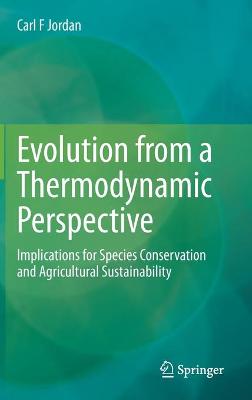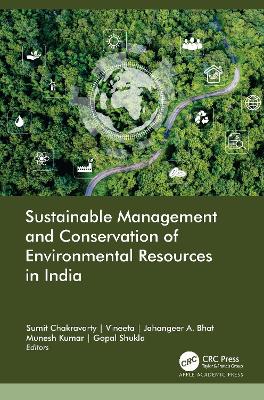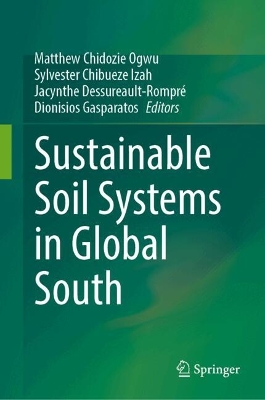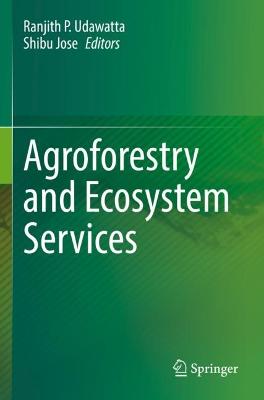Evolution from a Thermodynamic Perspective
 portes grátis
portes grátis
Evolution from a Thermodynamic Perspective
Implications for Species Conservation and Agricultural Sustainability
Jordan, Carl F
Springer Nature Switzerland AG
11/2021
384
Dura
Inglês
9783030851859
15 a 20 dias
781
Descrição não disponível.
C?ontents.- Part 1. Theory.- To Understand Economics, Follow the Money: To Understand Ecosystems, Follow the Energy.- Two Views of Ecology, Evolution, and Conservation.- Why I Wrote this Book.- Dualities Still Impede Conservation Efforts.- The Intergovernmental Science-Policy Platform of Biodiversity.- Targets for Conservation.- Evolving Objectives.- Literature Review.- Updating Ecosystem Ecology.- References.- What Can We Learn by Studying Ecosystems that We Can't Learn from Studying Populations?.- The Predator-Prey Conundrum.- The Serengeti Ecosystem.- Evolution in the "Ecological Theater".- Predator-Prey Interactions Tell Only Part of the Story.- Evolution in the "Thermodynamic Theater".- References.- A Thermodynamic Definition of Ecosystems.- Ecosystems in the 20th Century.- Cycling of Strontium-90.- Cesium-137 in Food Chains.- Recycling of Isotopes in Norwegian Sheep.- Ecological Energetics.- Is it Time to Bury the Ecosystem Concept?.- A Thermodynamic Definition of Life.- A Thermodynamic Definition of Ecosystems.- The Phase Transition between Order and Chaos.- References.- Thermodynamic Characteristics of Ecosystems.- Equilibrium.- The Equilibrium Law.- Thermodynamic Equilibrium.- Open Thermodynamic Systems.- Ecosystems are Thermodynamically Open Non-Equilibrium Systems.- Work is Performed by Non-equilibrium Systems.- Advantage of a Thermodynamically Open System.- 4.3 Ecosystems are Entropic.- 4.4 Ecosystems are Cybernetic.- Cybernetic Systems.- Economic Systems are Cybernetic Ecosystems are Cybernetic.- The Ecosystem Feedback Function.- Indirect vs. Direct Feedback.- Deviation Dampening and Amplifying Feedback.- Set Points.- Ecosystems are Autocatalytic.- Ecosystems have Boundaries.- Ecosystems are Hierarchical.- Hierarchy in Physical Systems.- Hierarchy in Ecological Systems.- Common Currencies.- Macro-and Micro-System Models.- Why an Ecosystem Model that Includes Everything is not Possible.- A Nested Marine Community.- Ecosystems are Deterministic.- Ecosystems are Information Rich.- An Engineering Definition of Information.- Information to Facilitate Exchange.- High Energy Information.- Low Energy Information.- Information Theory.- Genetic Information.- Ecosystems are Non-Teleological.- Criticisms of Ecosystem Models.- References.- Ecosystem Control: A Top-Down View.- Two Ways to Look at Systems.- Composing and Decomposing Trophic Webs.- Decomposers in Soil Organic Matter.- Decomposers in Marshes and Mangroves.- Control of Systems.- Top-Down vs. Bottom-Up.- Top-Down Exogenous Control.- Exogenous Impacts and Stability.- Top-Down Endogenous Control.- Endogenous Control through Nutrient Recycling.- Autocatalysis.- Control of Microbial Activity.- Inhibition of Microbial Activity by Leaf Sclerophylly.- Inhibition of Microbial Activity Chemical Defenses.- Inhibition of Microbial Activity by Ecological Stoichiometry.- The Synchrony Principle.- The Decay Law.- Direct Nutrient Cycling.- The Role of Animals.- Indirect Interactions.- Marine Systems.- Nutrient and Energy Recycling.- Exogenous Control.- Control in Lakes.- Control in Managed Ecosystems.- References.- Ecosystem Control: A Bottom-Up View.- Species as Arbitrageurs of Energy.- Relation Between Rate of Flow and Mass in Hydraulic Systems.- Relation Between Population Biomass and Rate of Energy Flow.- Equilibrium.- Mechanisms of Adjustment.- Adjustments and Climate Change.- Bird Populations.- Dis-equilibrium.- Population Instability vs. Ecosystem Instability.- Control by Interactions: Direct vs. Indirect.- Indirect Interactions.- Direct Interactions.- Predator - Prey.- Mutualisms.- Competition.- Decomposition.- Parasitism and Disease.- Commensalism and Amensalism.- Persistence of Negative Interactions.- References.- Ecosystem Stability.- Background.- A Thermodynamic Definition.- Regime Shift.- Metastability.- Pulsed Stability.- Resistance and Resilience.- Species Richness and Functional Stability.- Species Richness and Cultural Values.- Keystone Species, and Population and Ecosystem Stability.- 7.5.1 Keystone Species in the Yellowstone region of Wyoming.- References.- 8. Case Studies of Ecosystem Control and Stability.- Walden.- "Harmony in Nature".- Feedback Produces Nature's "Harmony".- Feedback Mechanisms.- Perturbations in Amazon Rain Forests.- Top-Down Control.- The San Carlos Project: A Small-scale, Low Intensity, Short Duration Disturbance.- 8.3.2 The Jari Project: A Large-scale, High Intensity, Long Duration Disturbance.- Bottom-Up Control.- The El Verde Project.- The Long-Term Ecological Research Project in Puerto Rico.- The Lago Guri Island Project.- The Biological Dynamics of Tropical Rainforest Fragments Project.- What have Case Studies Taught us about Stability of Tropical Ecosystems?.- Tropical Ecosystems are Stable.- Tropical Ecosystems are Unstable.- Energy Flow in Tropical Savannas and Rain Forests.- Insects in Tropical Ecosystems.- Application of Lessons to Other Regions.- Relevance to Temperate Zones.- Relevance to Aquatic Ecosystems.- The Experimental Lakes Project (Ecosystem Control of Species).- Lake Mendota Studies (Species Control of Ecosystems).- 8.7 Case Studies as Tests of Thermodynamic Theory.- References.- Entropy and Maximum Power.- Entropy.- 9.2 Entropy in a Steel Bar.- Thermodynamic Equilibrium.- Entropic Gradients.- Capturing and Storing Entropy.- Evapotranspiration and Entropy Reduction.- Life is a Balance between Storing and Releasing Entropy.- The Law of Maximum Entropy Production.- Energy for Metabolism as well as Growth.- Unassisted Entropy Capture is a Unique Characteristic of Life.-9.6Entropy Storage by Ecosystems.- 9.6.1 What Causes Entropy to be Stored?.- 9.7 Capturing Pressure.- 9.8 Entropy and Time.- 9.8.1 Time's Speed Regulator.- Efficiency of Energy Transformations.- Passage of Time for Cats.- 9.9The Maximum Power Principle.-9.10 Optimum Efficiencies for a Truck and its Driver.-9.11 Sustainability.- References.- A Thermodynamic View of Succession.- 10.1 The Population View.- 10.2 The Thermodynamic View.- 10.2.1 Leaf Area Index and Succession.- 10.2.2 Power Output as a Function of Leaf Area Index.- 10.2.3 What Causes Changes in Leaf Area Index?.- 10.2.4 Maximum Entropy Production Principle.- 10.2.5 Successional Ecosystems Move Further from Thermodynamic Equilibrium.- 10.2.6 Entropy Storage by Animals.- 10.3 The Strategy of Ecosystem Development.- A Problem with Odum's Strategy.- Why Power Output Continues to Increase.- Revised Definition of Maximum Power.- Costs of Ecosystem Stabilization.- Transactional Costs.- Succession, Power Output, and Efficiency.- 10.5.1 Kleiber's Law.- Are Ecosystems Spendthrifts?.- Interactions Between Species Facilitate Increase in Power Output.- Facilitation.- Tolerance.- Inhibition.- Intermediate Disturbance Hypothesis.- Nutrient Use Efficiency during Succession.- Succession Following Logging vs Following Agriculture.- 10.10 Thermodynamic View of Succession: Implications for Resource Management.- References.- Panarchy.- The Universal Cycle of Systems.- Panarchy.- Thermodynamic Interpretation of the Sacred Rules.- 11.2.1 Growth and Consolidation.- 11.2.2 Collapse.- Renewal.- Sub-systems.- Panarchy over 2 Billion Years of Evolution.- Consolidation, Bureaucracy and System Collapse.- Bureaucracy in Action (Case Studies).- Case Study: Panarchy in the Georgia Piedmont.- Thermodynamic Interpretation.- References.- 12. A Thermodynamic View of Evolution.- 12.1 Life - A Physicist's View.- 12.1.1 Life is Produced by Capturing Entropy.- 12.1.2 The Origin of Life.- 12.2 Two Approaches to Evolution.- 12.2.1 The Eco-Evo-Devo View.- 12.2.2 The Thermodynamic View.- 12.2.3 Fitness.- 12.2.4 The "Goal" of Evolution.- 12.3 The Relationship between Species and Environment.- 12.3.1 Evolution's "Theater".- 12.3.2 Is Evolution Stochastic or Deterministic?.- 12.4 Ecosystem Evolution.- 12.4.1 Succession was the Clue.- 12.4.2 Ecosystems Moved away from Equilibrium.- 12.4.3 Thermodynamic Mechanisms.- 12.4.4 Biological Mechanisms.- 12.4.5 Ecosystem Fitness.- 12.4.6 Ecosystems Evolve One Step at a Time.- 12.5. The Origin of Ecosystems .- 12.5.1 Origin of Feedback Loops.- 12.5.2 Origin of Trophic Levels.- 12.5.3 Why are there Trophic Levels?.- 12.6 The "Goal" of Ecosystem Evolution.- 12.6.1 Conflicting Goals?.- 12.6.2 "Motivations" of Species.- 12.6.3 The Earth Ecosystem.- 12.6.4 Why is there Resistance to the Idea of Ecosystem Evolution?.- 12.6.5 Evolution of Economic Systems.- 12.7 A Thermodynamic Model of Ecosystem Evolution.- 12.7.1 Network Models.- 12.7.2 Increase in Complexity of Trophic Webs.- 12.7.3 Evolution of Trophic Webs.- 12.7.4 Life Moves Ashore.- 12.8 Biodiversity and the Five Great Extinctions.- 12.8.1 The Cretaceous-Tertiary (K-T) Boundary Extinction.- 12.8.2The Amazing Sustainability of Trophic Chains.- 12.8.3 A Test of Thermodynamic Theory.- 12.9 Panarchy and Evolution.- 12.10 Thermodynamic Requirements for Living Systems on Other Planets.- References.- .-Why is Species Diversity Higher in the Tropics?.- 13.1 Tropical Explorations.- 13.2 A Few Theories.- 13.3 A Thermodynamic Explanation.- 13.3.1 The Latitudinal Energy Gradient.- 13.3.2 The Latitudinal Productivity Gradient.- 13.3.3 The Data.- 13.3.4 Other Factors Affecting Productivity.- 13.4 Empirical Evidence for a High Productivity High Diversity Correlation.- 13.5 Humboldt's Enigma.- 13.5.1 Are Productivity and Species Richness Correlated on Tropical.- Mountains?.- 13.6 The Mechanism Linking Productivity and Diversity.- 13.7 Answer to "Why is Species Diversity Higher in the Tropics?".- 13.7.1 Differences within the Tropics.- 13.8 Why is Species Diversity Low at High Latitudes?.- 13.9 An Economic Perspective on Diversity.- 13.9.1 Energy Flow, Economic Growth and Professional Diversity.- References.- What Have We Learned by Viewing Evolution from a Thermodynamic Perspective?.- 14.1 What we have Learned.- 14.1.1 Fitness Means Maximization of Power Output.- 14.1.2 Feedback is Essentialfor Sustainability.- 14.1.3 Control of Energy Flow Occurs both Top-down and Bottom-up.- 14.1.4 Storage of Entropy is a Powerful Characteristic of Living Systems.- 14.1.5 Evolution is the Storage of Entropy.- Objections to the Ecosystem Concept.- 15.1 Criticisms of the Ecosystem Concept.- 15.1.1 Ecosystems are Abstractions.- 15.1.2 Ecosystems are Ephemeral.- 15.1.3 Ecosystems are Oversimplifications.- 15.1.4 The Ecosystem Concept is Merely a Paradigm.- 15.1.5 The Ecosystem Concept is Not Based on Facts.- 15.2 Ecosystems are not Cybernetic.- 15.3 Inappropriate Machine Analogies.- 15.4 Objections to Ecosystem Evolution.- 15.4.1 No Measure of Fitness.- 15.4.2 Evolution has no Goals.- 15.4.3 The Theory Can't be Tested.- 15.4.4 No Mechanisms.- 15.4.5 Contradicts Neo-Darwinism.- 15.4.6 Restricted Definition.- 15.5 Setting up a Straw Man.- 15.6 Harmony in Nature?.- 15.7 Conservatism.- References.- What has Thermodynamics Taught us about Conservation?.- 16.1 "Habitat" is not Synonymous with "Ecosystem".- 16.2 Conservation and Feedback.- 16.3 A Few Case Studies.- 16.3.1 The Serengeti.- 16.3.2 Black Footed Ferret.- 16.3.3 Golden Lion Tamarin.- 16.3.4 Whooping Cranes.- 16.3.5 Puerto Rican Parrot.- 16.4 Conserving Feedback Loops.- 16.5 The Importance of Reservoirs for Recovery of Feedback Loops.- 16.6 Biodiversity Hotspots.- 16.7 A Conservationist's Dilemma.- 16.8 Conservation and Feedback: A Final Word.- References.- Part 2. Application.- Thermodynamic Laws and Agriculture.- 17. A Farmer's Dilemma.- 17.1 How Ecosystems and Economic Systems are the Same.- 17.2 How Ecosystems and Economic Systems are Different.- 17.3 Planet Earth is a Feedback System.- References.- 18. Agricultural Problems are Systems Problems.- 18.1 The Morrill Land-Grant Acts.- 18.2 The Evolution of Agricultural Research.- 18.2.1 Reductionism.- 18.2.2 The Empirical Approach.- 18.2.3 The Analytical Approach.- 18.3 Agricultural Development Models.- 18.3.3 The Ratchet Effect.- 18.4 The Systems Approach.- 18.4.1 Adaptive and Deterministic Cycles.- 18.4.2 Business Cycles and New Paradigms.- References.- Instability in Economic Food Systems.- 19.1 Pressures for Economic Expansion.- 19.1.1 Political Pressures.- 19.1.2 Humanitarian Challenges.- 19.1.3 Invested Academic Interests.- 19.2 Instability of Economic Food Systems: External Factors.- 19.2.1 Booms and Busts.- 19.2.2 Vulnerability of Farmers.- 19.3 Instability of Economic Food Systems: Internal Factors.- 19.3.1 Source of Energy for Yield.- 19.4 Lack of Feedback: Case Study.- 19.4.1 Data.- 19.4.1.1Energy Inputs.- 19.4.1.2 Energy Returned on Energy Invested.- 19.5 Control in Ecological vs. Economic Systems.- 19.6 The Emergence of Feedback and Control.- 19.7 Stability of Economic Food Systems.- References.- 20 Energy Efficiency in Agricultural Systems.- 20.1 Two Kinds of Energy.- 20.2 Early Comparisons of Energy Use Efficiency.- 20.3 Energy Returned on Energy Invested.- 20.4 EROI for Industrial Corn.- 20.4.1 Production Functions.- 20.4.2 An Energy Production Function.- 20.5 Economic Considerations.- 20.5.1 Income.- 20.5.2 Costs.- 20.5.3 Pro?t.- 20.6 A Farmer's Dilemma.- 20.7 The Maximum Power Principle and Economic Theory.- References.- The First Law of Thermodynamics and Genetic Engineering (There is no Free Lunch).- 21.1 Source of Energy for Increased Crop Yield.- 21.1.1 Endosomatic Energy.- 21.1.2 Hybridization.- 21.1.3 High Yield Rice.- 21.2 Domestication of Balsas teosinte.- 21.2.1 Calculations.- 21.2.2 Mechanisms.- 21.3 Other Tradeoffs.- 21.4 The Free Lunch has already been Eaten.- References.- 22 Top-down vs. Bottom-up Control in Resource Management Systems.- 22.1 Background.- 22.2 Experimental Site and Hypotheses.- 22.2.1 Methods.- 22.2.2 Traditional Agroforestry (Hierarchical level - the Ecosystem).- 22.2.3 Organic Production (Hierarchical level - local economic community).- 22.2.4 Sun Coffee Plantation (Hierarchical level - the corporate economy) 22.3 System Comparisons.- 22.3.1 Energy Input.- 23.3.2 Output.- 22.3.3 Results.- 22.4 Discussion.- 22.4.1 Effect of energy sources on system outputs.- 22.5 Conclusions.- 22.5.1 Feedback and Environmental Sustainability.- 22.5.2 Economic sustainability.- References.- 23 Services of Nature in Agricultural Systems.- 23.1 Services of Nature.- 23.2 The Nutrient Recycling Service of Nature.- 23.2.1 Erosion Prevention.- 23.3 Energy in Agricultural Systems.- 23.3.1Embedded Energy.- 23.3.2 Embodied Energy.- 23.4 The Systems Analyzed.- 23.5 Summary of Results.- 23.6 Discussion.- 23.6.1Shifting Cultivation.- 23.6.2. High Rates of Return on Exosomatic Inputs.- 23.6.3 Low Rates of Return on Exosomatic Inputs.- 23.6.4 Rates of Return on Endosomatic Inputs.- 23.6.5 Sustainability.- 23.6.6 Benefits and Costs of Herbicides.- References.- 24. Optimizing Sustainability.- 24.1 Two Views of Sustainability.- 24.2 A Compromise for Agriculture.- 24.2.1 Value of Services of Nature (Endosomatic Inputs).- 24.2.2 Value of Exosomatic Inputs.- 24.2.3 Energy vs. Dollars as a Measure of Sustainability.- 24.3 An Economic Model for Compromise.- 24.4 Case Studies.- 24.4.1 Pest Control by Services of Nature.- 24.5 Trends.- References.- 25 Agriculture that Incorporates Services of Nature.- 25.1 Environmentally Benign Agriculture.- 25.2 Intercropping.- 25.3 Regenerative Agriculture.- 25.4 Agroforestry.- 25.4.1 Agroforestry in Tropical Regions.- 25.4.2 Agroforestry in the Temperate Zone.- 25.5 Disadvantages of Agroforestry.- 25.6 The Governmental Perspective.- References.- 26 Rebuilding Natural Capital: A Case Study.- 26.1 The Nature of Capital.- 26.1.1 Depletion of Natural Capital.- 26.2 Rebuilding Natural Capital.- 26.3 An Obstacle to Rebuilding Natural Capital.- References.- Can Organic Agriculture Feed the World?.- 27.1 Organic Agriculture vs. Low- Energy-Input Agriculture.- 27.2 Organic Agriculture vs. Conventional Agriculture.- 27.3 Can Agriculture Dependent on Low Energy Input Feed the World?.- 27.4 Yield is Notthe Problem.- References.- What has Thermodynamics Taught us about Sustainability?.- What We Have Learned by Viewing Resource Management from a Thermodynamic Perspective?.- 28.1.1Services of Nature are Not Free.- Valuing Nature's Services and Natural Capital.- Natural Capital is not Recognized.- National Capital.- Energetic Value of Nature's Services.- 28.4 Taxes, Fees, and Reimbursements.- 28.5 Case Studies.- 28.5.1 Agriculture (The Plowman's Folly).- 28.5.2 Fisheries.- 28.5.3 Forestry.- 28.5.4 Species Conservation.- 28.5.5 Wildlife Management.- 28.5.6 Flood Control.- 28.5.7 Landscape Management.- 28.5.8 Climate Change.- 28.6 Natural Resources and the Free Market System.- References.- Part 3 Conservation.- Conservation of Resource Systems Means Preserving the Services of Nature.- In Wilderness is the Preservation of the World.- 29.1 Sacred Groves.- 29.2 Information is Stored in Sacred Groves.- 29.3Wilderness as a Resource Bank for Nature's Services.
Este título pertence ao(s) assunto(s) indicados(s). Para ver outros títulos clique no assunto desejado.
Ecosystem Evolution;Thermodynamic Process;Feedback and Ecosystem Stability;Endangered Species Conservation;Agricultural Sustainability
C?ontents.- Part 1. Theory.- To Understand Economics, Follow the Money: To Understand Ecosystems, Follow the Energy.- Two Views of Ecology, Evolution, and Conservation.- Why I Wrote this Book.- Dualities Still Impede Conservation Efforts.- The Intergovernmental Science-Policy Platform of Biodiversity.- Targets for Conservation.- Evolving Objectives.- Literature Review.- Updating Ecosystem Ecology.- References.- What Can We Learn by Studying Ecosystems that We Can't Learn from Studying Populations?.- The Predator-Prey Conundrum.- The Serengeti Ecosystem.- Evolution in the "Ecological Theater".- Predator-Prey Interactions Tell Only Part of the Story.- Evolution in the "Thermodynamic Theater".- References.- A Thermodynamic Definition of Ecosystems.- Ecosystems in the 20th Century.- Cycling of Strontium-90.- Cesium-137 in Food Chains.- Recycling of Isotopes in Norwegian Sheep.- Ecological Energetics.- Is it Time to Bury the Ecosystem Concept?.- A Thermodynamic Definition of Life.- A Thermodynamic Definition of Ecosystems.- The Phase Transition between Order and Chaos.- References.- Thermodynamic Characteristics of Ecosystems.- Equilibrium.- The Equilibrium Law.- Thermodynamic Equilibrium.- Open Thermodynamic Systems.- Ecosystems are Thermodynamically Open Non-Equilibrium Systems.- Work is Performed by Non-equilibrium Systems.- Advantage of a Thermodynamically Open System.- 4.3 Ecosystems are Entropic.- 4.4 Ecosystems are Cybernetic.- Cybernetic Systems.- Economic Systems are Cybernetic Ecosystems are Cybernetic.- The Ecosystem Feedback Function.- Indirect vs. Direct Feedback.- Deviation Dampening and Amplifying Feedback.- Set Points.- Ecosystems are Autocatalytic.- Ecosystems have Boundaries.- Ecosystems are Hierarchical.- Hierarchy in Physical Systems.- Hierarchy in Ecological Systems.- Common Currencies.- Macro-and Micro-System Models.- Why an Ecosystem Model that Includes Everything is not Possible.- A Nested Marine Community.- Ecosystems are Deterministic.- Ecosystems are Information Rich.- An Engineering Definition of Information.- Information to Facilitate Exchange.- High Energy Information.- Low Energy Information.- Information Theory.- Genetic Information.- Ecosystems are Non-Teleological.- Criticisms of Ecosystem Models.- References.- Ecosystem Control: A Top-Down View.- Two Ways to Look at Systems.- Composing and Decomposing Trophic Webs.- Decomposers in Soil Organic Matter.- Decomposers in Marshes and Mangroves.- Control of Systems.- Top-Down vs. Bottom-Up.- Top-Down Exogenous Control.- Exogenous Impacts and Stability.- Top-Down Endogenous Control.- Endogenous Control through Nutrient Recycling.- Autocatalysis.- Control of Microbial Activity.- Inhibition of Microbial Activity by Leaf Sclerophylly.- Inhibition of Microbial Activity Chemical Defenses.- Inhibition of Microbial Activity by Ecological Stoichiometry.- The Synchrony Principle.- The Decay Law.- Direct Nutrient Cycling.- The Role of Animals.- Indirect Interactions.- Marine Systems.- Nutrient and Energy Recycling.- Exogenous Control.- Control in Lakes.- Control in Managed Ecosystems.- References.- Ecosystem Control: A Bottom-Up View.- Species as Arbitrageurs of Energy.- Relation Between Rate of Flow and Mass in Hydraulic Systems.- Relation Between Population Biomass and Rate of Energy Flow.- Equilibrium.- Mechanisms of Adjustment.- Adjustments and Climate Change.- Bird Populations.- Dis-equilibrium.- Population Instability vs. Ecosystem Instability.- Control by Interactions: Direct vs. Indirect.- Indirect Interactions.- Direct Interactions.- Predator - Prey.- Mutualisms.- Competition.- Decomposition.- Parasitism and Disease.- Commensalism and Amensalism.- Persistence of Negative Interactions.- References.- Ecosystem Stability.- Background.- A Thermodynamic Definition.- Regime Shift.- Metastability.- Pulsed Stability.- Resistance and Resilience.- Species Richness and Functional Stability.- Species Richness and Cultural Values.- Keystone Species, and Population and Ecosystem Stability.- 7.5.1 Keystone Species in the Yellowstone region of Wyoming.- References.- 8. Case Studies of Ecosystem Control and Stability.- Walden.- "Harmony in Nature".- Feedback Produces Nature's "Harmony".- Feedback Mechanisms.- Perturbations in Amazon Rain Forests.- Top-Down Control.- The San Carlos Project: A Small-scale, Low Intensity, Short Duration Disturbance.- 8.3.2 The Jari Project: A Large-scale, High Intensity, Long Duration Disturbance.- Bottom-Up Control.- The El Verde Project.- The Long-Term Ecological Research Project in Puerto Rico.- The Lago Guri Island Project.- The Biological Dynamics of Tropical Rainforest Fragments Project.- What have Case Studies Taught us about Stability of Tropical Ecosystems?.- Tropical Ecosystems are Stable.- Tropical Ecosystems are Unstable.- Energy Flow in Tropical Savannas and Rain Forests.- Insects in Tropical Ecosystems.- Application of Lessons to Other Regions.- Relevance to Temperate Zones.- Relevance to Aquatic Ecosystems.- The Experimental Lakes Project (Ecosystem Control of Species).- Lake Mendota Studies (Species Control of Ecosystems).- 8.7 Case Studies as Tests of Thermodynamic Theory.- References.- Entropy and Maximum Power.- Entropy.- 9.2 Entropy in a Steel Bar.- Thermodynamic Equilibrium.- Entropic Gradients.- Capturing and Storing Entropy.- Evapotranspiration and Entropy Reduction.- Life is a Balance between Storing and Releasing Entropy.- The Law of Maximum Entropy Production.- Energy for Metabolism as well as Growth.- Unassisted Entropy Capture is a Unique Characteristic of Life.-9.6Entropy Storage by Ecosystems.- 9.6.1 What Causes Entropy to be Stored?.- 9.7 Capturing Pressure.- 9.8 Entropy and Time.- 9.8.1 Time's Speed Regulator.- Efficiency of Energy Transformations.- Passage of Time for Cats.- 9.9The Maximum Power Principle.-9.10 Optimum Efficiencies for a Truck and its Driver.-9.11 Sustainability.- References.- A Thermodynamic View of Succession.- 10.1 The Population View.- 10.2 The Thermodynamic View.- 10.2.1 Leaf Area Index and Succession.- 10.2.2 Power Output as a Function of Leaf Area Index.- 10.2.3 What Causes Changes in Leaf Area Index?.- 10.2.4 Maximum Entropy Production Principle.- 10.2.5 Successional Ecosystems Move Further from Thermodynamic Equilibrium.- 10.2.6 Entropy Storage by Animals.- 10.3 The Strategy of Ecosystem Development.- A Problem with Odum's Strategy.- Why Power Output Continues to Increase.- Revised Definition of Maximum Power.- Costs of Ecosystem Stabilization.- Transactional Costs.- Succession, Power Output, and Efficiency.- 10.5.1 Kleiber's Law.- Are Ecosystems Spendthrifts?.- Interactions Between Species Facilitate Increase in Power Output.- Facilitation.- Tolerance.- Inhibition.- Intermediate Disturbance Hypothesis.- Nutrient Use Efficiency during Succession.- Succession Following Logging vs Following Agriculture.- 10.10 Thermodynamic View of Succession: Implications for Resource Management.- References.- Panarchy.- The Universal Cycle of Systems.- Panarchy.- Thermodynamic Interpretation of the Sacred Rules.- 11.2.1 Growth and Consolidation.- 11.2.2 Collapse.- Renewal.- Sub-systems.- Panarchy over 2 Billion Years of Evolution.- Consolidation, Bureaucracy and System Collapse.- Bureaucracy in Action (Case Studies).- Case Study: Panarchy in the Georgia Piedmont.- Thermodynamic Interpretation.- References.- 12. A Thermodynamic View of Evolution.- 12.1 Life - A Physicist's View.- 12.1.1 Life is Produced by Capturing Entropy.- 12.1.2 The Origin of Life.- 12.2 Two Approaches to Evolution.- 12.2.1 The Eco-Evo-Devo View.- 12.2.2 The Thermodynamic View.- 12.2.3 Fitness.- 12.2.4 The "Goal" of Evolution.- 12.3 The Relationship between Species and Environment.- 12.3.1 Evolution's "Theater".- 12.3.2 Is Evolution Stochastic or Deterministic?.- 12.4 Ecosystem Evolution.- 12.4.1 Succession was the Clue.- 12.4.2 Ecosystems Moved away from Equilibrium.- 12.4.3 Thermodynamic Mechanisms.- 12.4.4 Biological Mechanisms.- 12.4.5 Ecosystem Fitness.- 12.4.6 Ecosystems Evolve One Step at a Time.- 12.5. The Origin of Ecosystems .- 12.5.1 Origin of Feedback Loops.- 12.5.2 Origin of Trophic Levels.- 12.5.3 Why are there Trophic Levels?.- 12.6 The "Goal" of Ecosystem Evolution.- 12.6.1 Conflicting Goals?.- 12.6.2 "Motivations" of Species.- 12.6.3 The Earth Ecosystem.- 12.6.4 Why is there Resistance to the Idea of Ecosystem Evolution?.- 12.6.5 Evolution of Economic Systems.- 12.7 A Thermodynamic Model of Ecosystem Evolution.- 12.7.1 Network Models.- 12.7.2 Increase in Complexity of Trophic Webs.- 12.7.3 Evolution of Trophic Webs.- 12.7.4 Life Moves Ashore.- 12.8 Biodiversity and the Five Great Extinctions.- 12.8.1 The Cretaceous-Tertiary (K-T) Boundary Extinction.- 12.8.2The Amazing Sustainability of Trophic Chains.- 12.8.3 A Test of Thermodynamic Theory.- 12.9 Panarchy and Evolution.- 12.10 Thermodynamic Requirements for Living Systems on Other Planets.- References.- .-Why is Species Diversity Higher in the Tropics?.- 13.1 Tropical Explorations.- 13.2 A Few Theories.- 13.3 A Thermodynamic Explanation.- 13.3.1 The Latitudinal Energy Gradient.- 13.3.2 The Latitudinal Productivity Gradient.- 13.3.3 The Data.- 13.3.4 Other Factors Affecting Productivity.- 13.4 Empirical Evidence for a High Productivity High Diversity Correlation.- 13.5 Humboldt's Enigma.- 13.5.1 Are Productivity and Species Richness Correlated on Tropical.- Mountains?.- 13.6 The Mechanism Linking Productivity and Diversity.- 13.7 Answer to "Why is Species Diversity Higher in the Tropics?".- 13.7.1 Differences within the Tropics.- 13.8 Why is Species Diversity Low at High Latitudes?.- 13.9 An Economic Perspective on Diversity.- 13.9.1 Energy Flow, Economic Growth and Professional Diversity.- References.- What Have We Learned by Viewing Evolution from a Thermodynamic Perspective?.- 14.1 What we have Learned.- 14.1.1 Fitness Means Maximization of Power Output.- 14.1.2 Feedback is Essentialfor Sustainability.- 14.1.3 Control of Energy Flow Occurs both Top-down and Bottom-up.- 14.1.4 Storage of Entropy is a Powerful Characteristic of Living Systems.- 14.1.5 Evolution is the Storage of Entropy.- Objections to the Ecosystem Concept.- 15.1 Criticisms of the Ecosystem Concept.- 15.1.1 Ecosystems are Abstractions.- 15.1.2 Ecosystems are Ephemeral.- 15.1.3 Ecosystems are Oversimplifications.- 15.1.4 The Ecosystem Concept is Merely a Paradigm.- 15.1.5 The Ecosystem Concept is Not Based on Facts.- 15.2 Ecosystems are not Cybernetic.- 15.3 Inappropriate Machine Analogies.- 15.4 Objections to Ecosystem Evolution.- 15.4.1 No Measure of Fitness.- 15.4.2 Evolution has no Goals.- 15.4.3 The Theory Can't be Tested.- 15.4.4 No Mechanisms.- 15.4.5 Contradicts Neo-Darwinism.- 15.4.6 Restricted Definition.- 15.5 Setting up a Straw Man.- 15.6 Harmony in Nature?.- 15.7 Conservatism.- References.- What has Thermodynamics Taught us about Conservation?.- 16.1 "Habitat" is not Synonymous with "Ecosystem".- 16.2 Conservation and Feedback.- 16.3 A Few Case Studies.- 16.3.1 The Serengeti.- 16.3.2 Black Footed Ferret.- 16.3.3 Golden Lion Tamarin.- 16.3.4 Whooping Cranes.- 16.3.5 Puerto Rican Parrot.- 16.4 Conserving Feedback Loops.- 16.5 The Importance of Reservoirs for Recovery of Feedback Loops.- 16.6 Biodiversity Hotspots.- 16.7 A Conservationist's Dilemma.- 16.8 Conservation and Feedback: A Final Word.- References.- Part 2. Application.- Thermodynamic Laws and Agriculture.- 17. A Farmer's Dilemma.- 17.1 How Ecosystems and Economic Systems are the Same.- 17.2 How Ecosystems and Economic Systems are Different.- 17.3 Planet Earth is a Feedback System.- References.- 18. Agricultural Problems are Systems Problems.- 18.1 The Morrill Land-Grant Acts.- 18.2 The Evolution of Agricultural Research.- 18.2.1 Reductionism.- 18.2.2 The Empirical Approach.- 18.2.3 The Analytical Approach.- 18.3 Agricultural Development Models.- 18.3.3 The Ratchet Effect.- 18.4 The Systems Approach.- 18.4.1 Adaptive and Deterministic Cycles.- 18.4.2 Business Cycles and New Paradigms.- References.- Instability in Economic Food Systems.- 19.1 Pressures for Economic Expansion.- 19.1.1 Political Pressures.- 19.1.2 Humanitarian Challenges.- 19.1.3 Invested Academic Interests.- 19.2 Instability of Economic Food Systems: External Factors.- 19.2.1 Booms and Busts.- 19.2.2 Vulnerability of Farmers.- 19.3 Instability of Economic Food Systems: Internal Factors.- 19.3.1 Source of Energy for Yield.- 19.4 Lack of Feedback: Case Study.- 19.4.1 Data.- 19.4.1.1Energy Inputs.- 19.4.1.2 Energy Returned on Energy Invested.- 19.5 Control in Ecological vs. Economic Systems.- 19.6 The Emergence of Feedback and Control.- 19.7 Stability of Economic Food Systems.- References.- 20 Energy Efficiency in Agricultural Systems.- 20.1 Two Kinds of Energy.- 20.2 Early Comparisons of Energy Use Efficiency.- 20.3 Energy Returned on Energy Invested.- 20.4 EROI for Industrial Corn.- 20.4.1 Production Functions.- 20.4.2 An Energy Production Function.- 20.5 Economic Considerations.- 20.5.1 Income.- 20.5.2 Costs.- 20.5.3 Pro?t.- 20.6 A Farmer's Dilemma.- 20.7 The Maximum Power Principle and Economic Theory.- References.- The First Law of Thermodynamics and Genetic Engineering (There is no Free Lunch).- 21.1 Source of Energy for Increased Crop Yield.- 21.1.1 Endosomatic Energy.- 21.1.2 Hybridization.- 21.1.3 High Yield Rice.- 21.2 Domestication of Balsas teosinte.- 21.2.1 Calculations.- 21.2.2 Mechanisms.- 21.3 Other Tradeoffs.- 21.4 The Free Lunch has already been Eaten.- References.- 22 Top-down vs. Bottom-up Control in Resource Management Systems.- 22.1 Background.- 22.2 Experimental Site and Hypotheses.- 22.2.1 Methods.- 22.2.2 Traditional Agroforestry (Hierarchical level - the Ecosystem).- 22.2.3 Organic Production (Hierarchical level - local economic community).- 22.2.4 Sun Coffee Plantation (Hierarchical level - the corporate economy) 22.3 System Comparisons.- 22.3.1 Energy Input.- 23.3.2 Output.- 22.3.3 Results.- 22.4 Discussion.- 22.4.1 Effect of energy sources on system outputs.- 22.5 Conclusions.- 22.5.1 Feedback and Environmental Sustainability.- 22.5.2 Economic sustainability.- References.- 23 Services of Nature in Agricultural Systems.- 23.1 Services of Nature.- 23.2 The Nutrient Recycling Service of Nature.- 23.2.1 Erosion Prevention.- 23.3 Energy in Agricultural Systems.- 23.3.1Embedded Energy.- 23.3.2 Embodied Energy.- 23.4 The Systems Analyzed.- 23.5 Summary of Results.- 23.6 Discussion.- 23.6.1Shifting Cultivation.- 23.6.2. High Rates of Return on Exosomatic Inputs.- 23.6.3 Low Rates of Return on Exosomatic Inputs.- 23.6.4 Rates of Return on Endosomatic Inputs.- 23.6.5 Sustainability.- 23.6.6 Benefits and Costs of Herbicides.- References.- 24. Optimizing Sustainability.- 24.1 Two Views of Sustainability.- 24.2 A Compromise for Agriculture.- 24.2.1 Value of Services of Nature (Endosomatic Inputs).- 24.2.2 Value of Exosomatic Inputs.- 24.2.3 Energy vs. Dollars as a Measure of Sustainability.- 24.3 An Economic Model for Compromise.- 24.4 Case Studies.- 24.4.1 Pest Control by Services of Nature.- 24.5 Trends.- References.- 25 Agriculture that Incorporates Services of Nature.- 25.1 Environmentally Benign Agriculture.- 25.2 Intercropping.- 25.3 Regenerative Agriculture.- 25.4 Agroforestry.- 25.4.1 Agroforestry in Tropical Regions.- 25.4.2 Agroforestry in the Temperate Zone.- 25.5 Disadvantages of Agroforestry.- 25.6 The Governmental Perspective.- References.- 26 Rebuilding Natural Capital: A Case Study.- 26.1 The Nature of Capital.- 26.1.1 Depletion of Natural Capital.- 26.2 Rebuilding Natural Capital.- 26.3 An Obstacle to Rebuilding Natural Capital.- References.- Can Organic Agriculture Feed the World?.- 27.1 Organic Agriculture vs. Low- Energy-Input Agriculture.- 27.2 Organic Agriculture vs. Conventional Agriculture.- 27.3 Can Agriculture Dependent on Low Energy Input Feed the World?.- 27.4 Yield is Notthe Problem.- References.- What has Thermodynamics Taught us about Sustainability?.- What We Have Learned by Viewing Resource Management from a Thermodynamic Perspective?.- 28.1.1Services of Nature are Not Free.- Valuing Nature's Services and Natural Capital.- Natural Capital is not Recognized.- National Capital.- Energetic Value of Nature's Services.- 28.4 Taxes, Fees, and Reimbursements.- 28.5 Case Studies.- 28.5.1 Agriculture (The Plowman's Folly).- 28.5.2 Fisheries.- 28.5.3 Forestry.- 28.5.4 Species Conservation.- 28.5.5 Wildlife Management.- 28.5.6 Flood Control.- 28.5.7 Landscape Management.- 28.5.8 Climate Change.- 28.6 Natural Resources and the Free Market System.- References.- Part 3 Conservation.- Conservation of Resource Systems Means Preserving the Services of Nature.- In Wilderness is the Preservation of the World.- 29.1 Sacred Groves.- 29.2 Information is Stored in Sacred Groves.- 29.3Wilderness as a Resource Bank for Nature's Services.
Este título pertence ao(s) assunto(s) indicados(s). Para ver outros títulos clique no assunto desejado.







